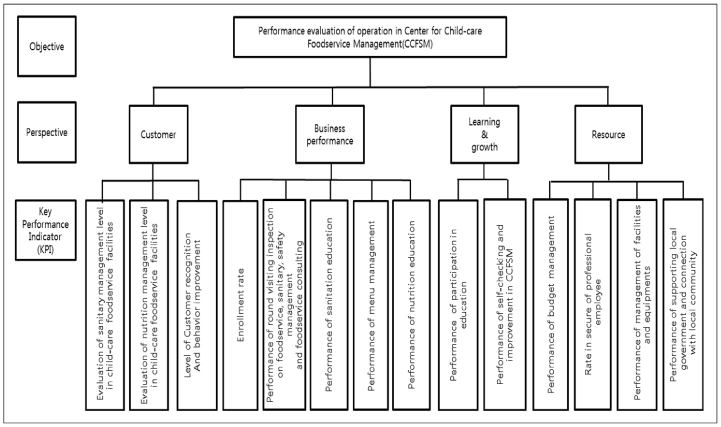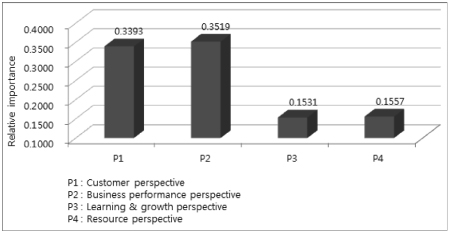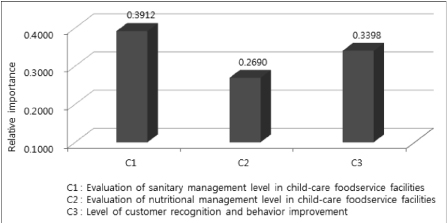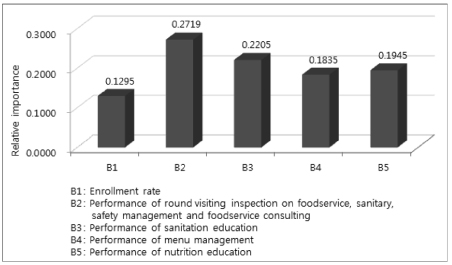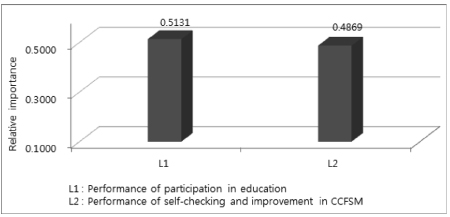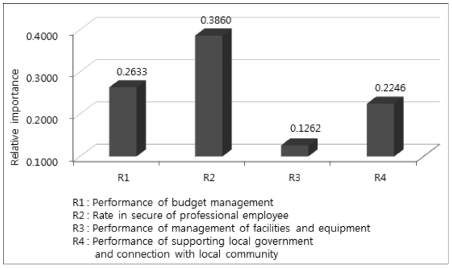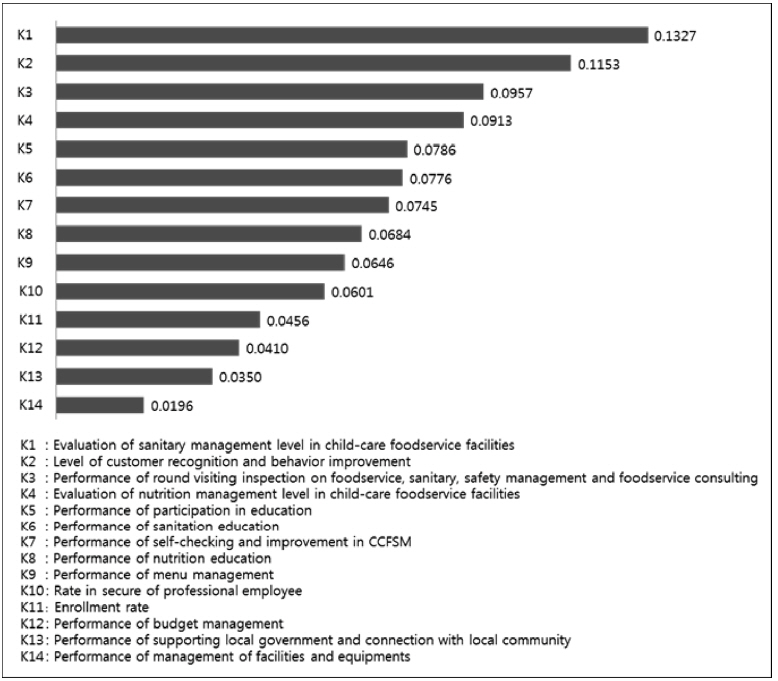Korean J Community Nutr.
2013 Apr;18(2):154-164. 10.5720/kjcn.2013.18.2.154.
Analysis of Relative Importance of Key Performance Indicators for Center for Child-Care Foodservice Management through Analytic Hierarchy Process (AHP)
- Affiliations
-
- 1Deptartment of Food and Nutrition, Yonsei University, Seoul, Korea.
- 2Department of Food Science and Nutrition, Jeju National University, Jeju, Korea.
- 3Institute of Symbiotic Life-TECH, Yonsei University, Seoul, Korea.
- 4Department of Food and Nutrition, Sangji University, Wonju, Korea. hy1317@sangji.ac.kr
- KMID: 2267498
- DOI: http://doi.org/10.5720/kjcn.2013.18.2.154
Abstract
- The objectives of this study were to assign reasonability to importance of weight selection issue in key performance indicator for performance evaluation of Centers for Child-care Foodservice Management (CCFSM) developed by using Balanced Scorecard (BSC), to draw key performance indicator (KPI) by perspective and to analyze differences in recognition on importance. From September 25 to October 9, 2012, we conducted a questionnaire-based study via e-mail, targeting chiefs and team leaders of nationwide 21 CCFSMs (43 persons), officials of local governments where CCFSM was established (21 persons), officials of Korea Food and Drug Administration (2 persons) and foodservice management experts (27 persons) in order to estimate the relative importance on 4 perspectives and 14 KPIs and analyzed its results by using 61 collected data. The results showed that relative importance of perspectives was estimated in order of importance as follows: business performance (0.3519), customer (0.3393), resource (0.1557), learning and growth (0.1531). Relative importance of KPIs was in order of importance as follows: Evaluation of sanitary management level in childcare foodservice facilities (0.1327), Level of customer recognition and behavior improvement (0.1153), performances of round visiting inspection on foodservice, sanitary, safety management, and foodservice consulting (0.0913). Our results showed that the recognition differences exist on the relative importance of perspectives and KPIs between officials of CCFSM, KFDA, local government and foodservice management experts. These observations will form the basis for developing evaluation systems, and it is considered that performance indicators developed on this basis will suggest direction of operation which CCFSM will have to perform.
Keyword
MeSH Terms
Figure
Reference
-
1. Chang ML, Kim YB. A study of the actual conditions of kindergarten meals program. Korean J Early Child Educ. 2003; 23(3):261–284.2. Staskel DM, Briley ME, Field LH, Barth SS. Microbial evaluation of foodservice surfaces in texas child-care centers. J Am Diet Assoc. 2007; 107(5):854–859.
Article3. Harker PT, Vargas LG. The theory of ratio scale estimation: Saaty\'s analytic hierarchy process. Manage Sci. 1987; 33(11):1383–1403.
Article4. Hwang DY, Kang KH, Gim KM, Baek MH. Development of woman farmers center performance indicators by using the analytic hierarchy process. J Agric Extension Community Dev. 2008; 15(4):599–619.5. Jang YL. Development of sustainable eco-tourism evaluation models and indicators: Focusing on the specialist of eco-tourism by AHP analysis. Korean J Tourism Res. 2012; 27(2):455–475.6. Jin JG. Government productivity: Conceptual framework and measures. In: Korean Institute of Public Administration KIPA Research Report. 1998. pp. 0-117.7. Kaplan RS, Norton DP. The balanced scorecard-measures that drive performance. Harv Bus Rev. 1992; 70(1):71–79.8. Kim DK, Park YW, Lee SM. Assessment of tourism resource development by the analytic hierarchy process: Focusing on the planning process. Korea J Tourism Hosp Res. 2007; 21(4):5–18.9. Kim EH. A study on the development of performance evaluation model of the disabled welfare institutions using BSC and AHP. Korean Policy Sci Rev. 2010; 14(4):143–171.10. Kim HK, Sung ES. In: BSC Practice Manual. Sigmainsight; 2004.11. Kim HJ, Lim HG, Kim DG. The development on significancy and priority of KPI in contracted foodservice business in Korea using AHP. Korea J Tourism Hosp Res. 2011; 25(4):163–176.12. Kim ST, Ahn SS, Lee HY. A study on the development of a CSR(Corporate Social Responsibility) evaluation model: with application of AHP(Analytic Hierarchy Process) technique. Acad Customer Satisf Manag. 2011; 13(1):169–187.13. Kim SY, Yang IS, Yi BS, Baek SH, Shin SY, Lee HY. Childcare facility and kindergartens demands on foodservice support by center for child-care foodservice management (CCFSM) inSeoul and Gyeonggi-do. Korean J Community Nutr. 2011; 16(6):730–739.14. Kim HK, Kim HJ. The development on significancy and priority of KPI in Korean coffee shop business using AHP. Korean J Hosp Adm. 2012; 21(5):195–205.15. Kim JH, Kim WJ, Cho HK, Lee EY, Seo MW. A study on the development of evaluation model for selecting a standard for DITA using AHP. Ind Eng Interfaces. 2012; 25(1):96–105.
Article16. Ko YS, Yoon HS, Lee JH. In: Performance management in public service. Korea Development Institute; 2004.17. Kwak TK, Lee HS, Yang IS. Assessment of food service management practices in day care centers. Korean J Soc Food Sci. 1991; 7(4):103–109.18. Lee SG. Consolidated performance management for local governments with the introduction of performance-based budgeting system: With special reference to the case of Seoul metropolitan government. Korean J Local Finance. 2003; 8(1):135–162.19. Lee BS. The survey on the foodservice management system of the child care centers in Ansan. Korean J Food Nutr. 2006; 19(4):435–447.20. Lee MA, Yang IS, Yi BS, Kim HA, Park SH. Analytic hierarchy process approach to estimate weights of evaluation categories for school food service program in Korea. Korean J Nutr. 2006; 39(1):74–83.21. Lee MS, Lee JY, Yoon SH. Assessment of foodservice management performance at child care centers. Korean J Community Nutr. 2006; 11(2):229–239.22. Lee WS. Selection of indicator and establishment of system for a functional assessment of green space: Focused on forest green space. J Korea Soc Environ Restor Tech. 2012; 15(5):31–48.23. Park JH. A study on civil administration service current and improvement method of central government. In: Korean Association for Public Administration Summer Consortium. 2000. pp. 553-568.24. Park JH, Han HJ, L KJ, Park BS. Analysis and improvement in performance evaluation system and actual administration. In: KIPA Research Report. 2004. pp. 1-162.25. Park S, Hong YW, Na JK. A method for selecting the evaluation index of defence R&D project by AHP. J Korean Data Inf Sci Soc. 2012; 23(5):961–970.26. Park YM. A study on performance indicator of disabled welfare service. Jeonnam Assoc Public Adm. 2001; 8:413–431.27. Saaty TL, Aczel J. Procedures for synthesizing ratio judgements. J Math Psychol. 1983; 27(1):93–102.28. Saaty TL. In: Fundamental of decision making and prority theory with the analytic hierarchy process. Pittsburg: RWS Publications; 1994.29. Saaty TL. In: Decision making for leader: the analytic hierarchy process for decisions in a complex world. Pittsburg: RWS Publications; 1999.30. Sohn CY, Yang IS. A analysis of relative importance of evaluation categories for hospital food service by analytic hierarchy process. Korean J Food Nutr. 2010; 23(4):470–477.31. Staskel DM, Briley ME, Field LH, Barth SS. Microbial evaluation of foodservice surfaces in texas child-care centers. J Am Diet Assoc. 2007; 107(5):854–859.
Article32. Um DH, Kim DS, Kim TC, Kim ES. A study on the Development of green-tourism performance indicators by using BSC on rural village. J Korean Soc Rural Plan. 2006; 12(3):43–55.33. Wholey JS, Hatry HP. The case for performance monitoring. Public Adm Rev. 1992; 52(6):604–610.
Article34. Yoon SJ, Kim KS, Kang ES. Application strategies on the BSC model of public performance evaluation system. In: KIPA Research Report. 2005. pp. 1-149.
- Full Text Links
- Actions
-
Cited
- CITED
-
- Close
- Share
- Similar articles
-
- Application of Analytical Hierarchy Process in Analyzing the Priorities of Strategy for Improving the Army Military Foodservice
- Analysis of the relative importance of key factors in nursing workforce management for pandemic response in general hospitals and long-term care hospitals
- Decision Making Regarding Key Elements of Korean Disaster Psychiatric Assistance Teams Using the Analytic Hierarchy Process
- Analytic Hierarchy Process approach to estimate weights of menu management in the school foodservice
- A new performance evaluation indicator for the LEE Jong-wook Fellowship Program of Korea Foundation for International Healthcare to better assess its long-term educational impacts: a Delphi study

